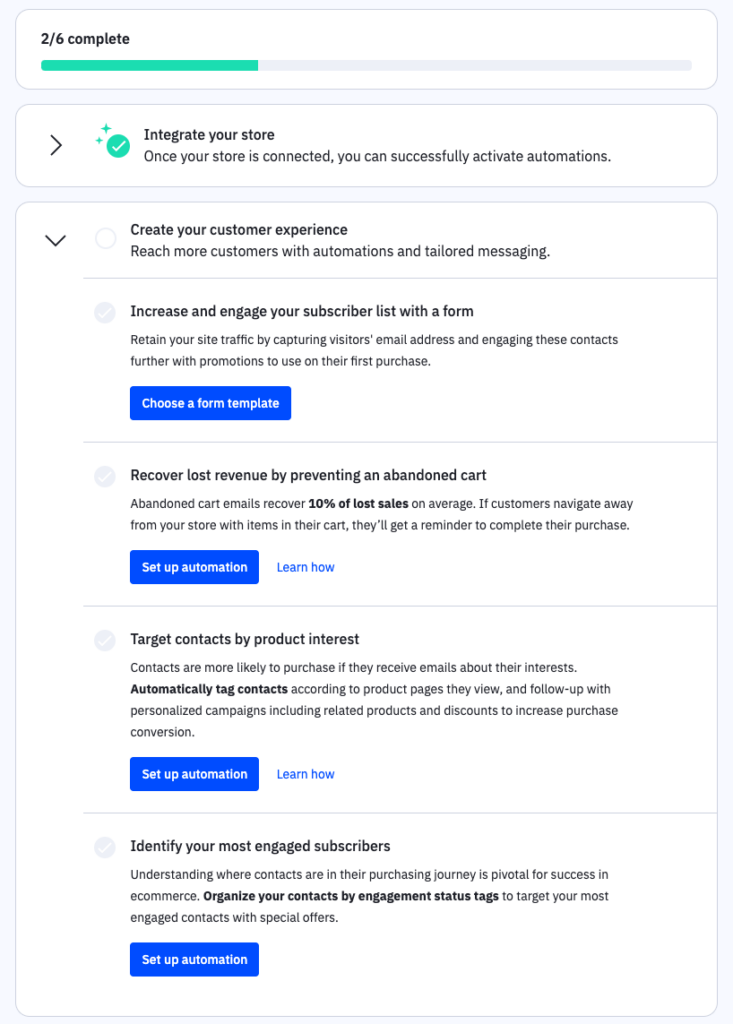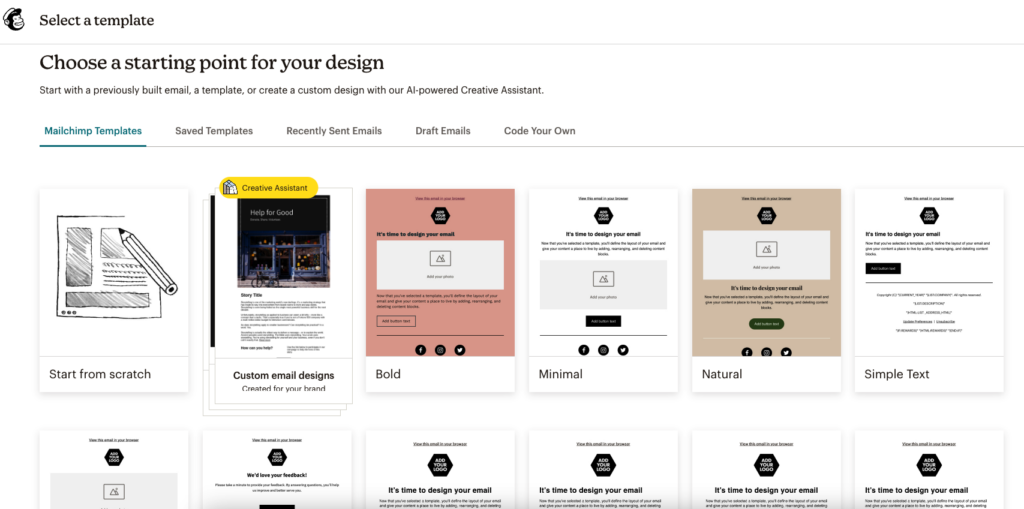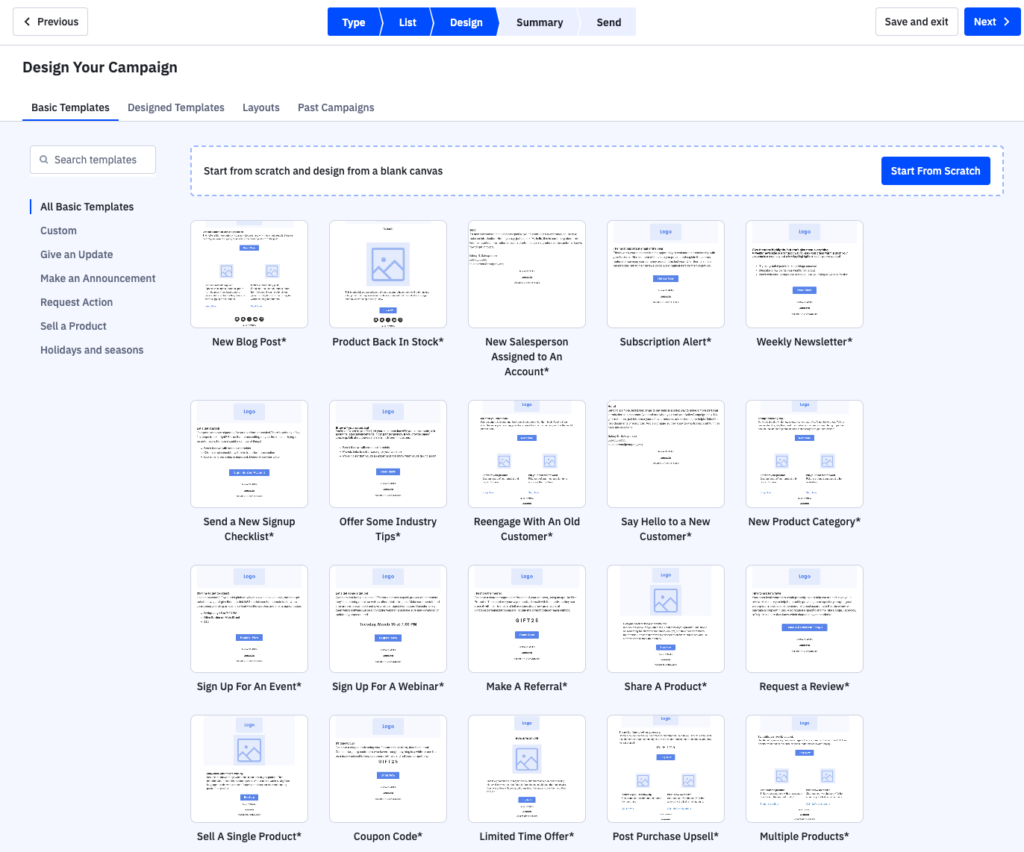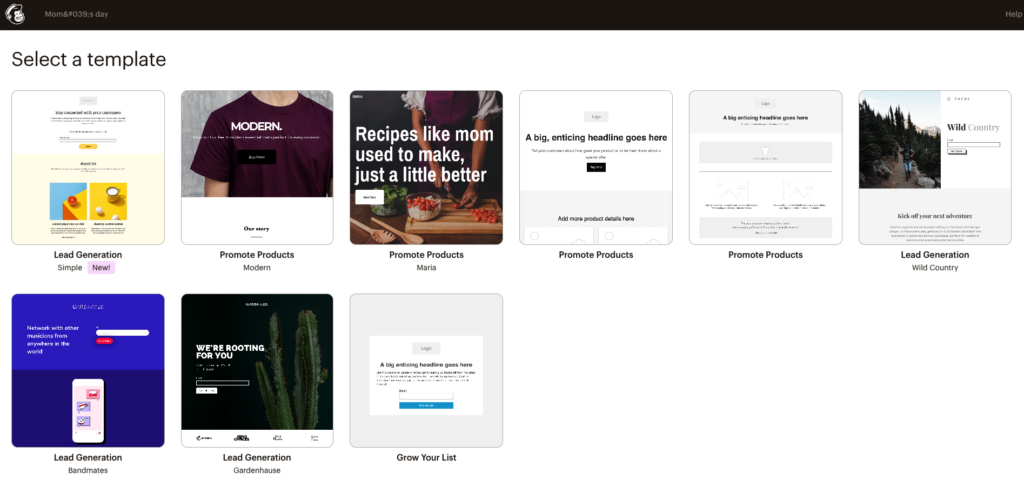The winner – Mailchimp
Life-changing superhero
In this comparison, Mailchimp wins four out of eleven rounds. Four rounds end in a tie, and there are three aspects where ActiveCampaign outperforms Mailchimp. Continue reading to learn about the cases where Mailchimp outperforms ActiveCampaign and why.
What Mailchimp features are better than ActiveCampaign
- Email builder is more intuitive
- Better compatibility with social media channels
- AI assistance is more developed and better integrated
- Better price
- Email builder usability lags behind
- Integration with Facebook Audiences and Messegnger, no other social channels
- Poor AI assistance
- For advanced features you have to pay for the highest tier plans
ActiveCampaign or Mailchimp: Which one should you choose to achieve the results you want?
These are two widely used email marketing platforms. Both platforms offer similar features suitable for matured businesses. However, the devil is in the details.
In this post, we will thoroughly compare these powerful platforms. We will examine their key features and pricing models to help you make an informed decision regarding your email marketing requirements.
ActiveCampaign vs Mailchimp: Quick overview
ActiveCampaign boasts a rating of 4.4 out of 5 on the Shopify app store. Its strengths lie in its powerful automation, segmentation, and analytics.
Mailchimp, on the other hand, is a beginner-friendly platform with a rating of 3.3 out of 5 on Shopify. It offers a free plan and a range of features that can enhance your email campaigns.
Here’s a comparison table that provides a brief summary of the two tools:
ActiveCampaign vs Mailchimp: Feature-by-feature comparison
Now, let’s delve into a detailed examination of the features offered by these two platforms.
Ease of getting started
Both ActiveCampaign and Mailchimp make it relatively simple to sign up and get started. The interface of both platforms is well-organized, and they both offer a “getting started” checklist to guide users through the setup process.
However, Mailchimp’s sign-up process involves an additional step of email verification. In contrast, ActiveCampaign provides immediate access after submitting the form.
While both platforms offer a wide range of features, finding some settings can be challenging. For example, on Mailchimp’s platform, we struggled to find how to remove the Mailchimp logo from emails.
ActiveCampaign also provides advanced settings and a wide range of functionality that may require some technical know-how to manage effectively. Additionally, some terms on the platform differ from those used on most platforms, so it may take some time to understand them and locate specific functions.

Mailchimp is better suited for beginners and users who are not tech-savvy.
Both platforms have a straightforward setup process and offer a wide range of features. However, there is a learning curve associated with using ActiveCampaign.
Building an email campaign
The email campaign-building features of Mailchimp and ActiveCampaign have their strengths and areas for improvement.
Both platforms offer drag-and-drop email campaign builders, pre-built templates, and a product catalog feature.
To see a quick comparison of their email campaign building capabilities, refer to the table below:
Mailchimp does offer some unique features, but accessing them requires upgrading to higher plan tiers. One such feature is “dynamic content blocks,” which enable you to display different information to different recipients within a single email.
Another noteworthy feature is the “Inbox Preview,” which provides a screenshot of your email, allowing you to see how it appears across devices and email clients. You will receive 25 Litmus tokens each month.

ActiveCampaign allows you to create segments within the email campaign wizard, and you can utilize the global settings to establish your brand style for future emails.
Personalizing your emails is also possible by incorporating customer data into the subject line and email body.
A useful feature offered by ActiveCampaign is “Message Variables,” which allows you to retrieve constant values (such as an email signature) from a centralized location. However, the email builder in ActiveCampaign isn’t as intuitive as Mailchimp’s and doesn’t differ significantly from what most other platforms offer.

Mailchimp stands out with its dynamic content blocks, Inbox Preview, and the ability to attach polls and surveys.
ActiveCampaign, on the other hand, provides good email templates and features like message variables. However, when it comes to overall usability and customization, Mailchimp’s email builder surpasses that of ActiveCampaign.
Marketing automation
Both platforms offer the essential components of marketing automation, including pre-built workflows, an editor, and the ability to set triggers and conditions. It’s important to note that while the logic is available, you still need to add the content and design emails by yourself, or with the help of AI assistant. Both paltforms offer this feature.
The difference, however, lies in the level of sophistication.
Mailchimp offers “classic automation” triggers for welcome emails, purchases, email opens, and abandoned carts. Additionally, it offers over 70+ pre-built workflows (customer journeys) combining different social media and other channels via integrations.

ActiveCampaign offers very similar and even more advanced marketing automation combinations with CRM and sales integrations, enabling users to create complex workflows with customized settings.
One unique feature of ActiveCampaign is the “Automation Maps,” which provide a visual representation of all the interconnected flows. This comprehensive overview helps users identify bottlenecks and gain a better understanding of their workflow.

The only drawback is that there is a learning curve involved in understanding and utilizing all the automation options. This aspect can be challenging, particularly for beginners.
ActiveCampaign emerges as the winner with its robust automation capabilities.
Although Mailchimp offers pre-built workflows and an extensive list of triggers, the overall options aren’t as extensive as those provided by ActiveCampaign.
Signup forms and landing pages
Mailchimp offers basic signup forms that you can adapt to your brand look. There is no template library for the popups or other forms. This is where Mailchimp falls behind platforms like Omnisend and Klaviyo, which provide ready-to-use forms and multiple templates.
Additionally, in Mailchimp, you can only display one popup on your site at a time. There’s no option to show custom popups to different visitors or to combine exit-intent with immediate popups.
The process of customizing signup forms in Mailchimp isn’t as intuitive as one would expect. Users also need to pay attention to the size of the forms, as they aren’t mobile-responsive by default.
On the other hand, Mailchimp has great landing pages.

When it comes to Active Campaign, this platform also doesn’t shine in terms of signup forms. All you can find here is a few layouts and a standard functionality to make your popup match your brand style.
Also, be aware that in ActiveCampaign, popups are called modals and they don’t have a time delay function, only scroll delay.
It’s a tie. Both platforms have room for improvement in terms of their signup form offerings.
Segmentation
Importing and organizing contacts in ActiveCampaign is a straightforward process. Users can segment contacts based on demographics, email actions, shopping behaviors, tags, or custom fields. Additionally, up to 20 conditions can be added within a segment.
To create more targeted email campaigns, use tags and custom fields to segment your lists.
ActiveCampaign also offers a standout feature called the “floating” segment builder, which allows users to create segments from various sections across the platform. This feature saves time when it comes to segment building.
However, ActiveCampaign doesn’t offer any pre-built segments that usually help marketers save time.
In comparison, Mailchimp offers both simple and advanced segmentation features, with the advanced options only available in higher plan tiers. Here you’ll find three ready audiences.
Segments can be created based on a lot of criteria such as user activity, contact information, engagement, purchasing behavior, and more.
Each segment in Mailchimp can include up to five conditions.
One major flaw of Mailchimp is that this platform charges for each contact and doesn’t ignore duplicate contacts across separate lists. Therefore, you have to regularly clean your database or risk paying twice for repeated contacts.
ActiveCampaign wins. This platform offers greater flexibility and enhanced segmentation features, including a floating segment builder.
Analytics
Mailchimp offers campaigns, landing pages, and automation analytics. Key campaign metrics include open rates, unsubscribes, bounce rates, and click-through rates.
Mailchimp also gives you advanced reports, such as comparative reports that compile data from your sent regular and RSS campaigns into a comprehensive report.
However, this feature is only available with the premium plan. One significant drawback is the absence of real-time reporting, which is offered by other platforms.
ActiveCampaign offers comprehensive campaign analytics, engagement segmentation, subscriber data, and more.
Contact trends reports are available to show how contacts are interacting with your emails, along with a contact growth graph.
Another notable feature that gives ActiveCampaign an edge over Mailchimp is the Deal Overview Reports, which provides you insights on the total number of sales deals lost, created, and won.
To access advanced reports like conversion, store performance, and revenue, upgrading to the Premium plan is necessary.
ActiveCampaign takes the lead in terms of in-depth analytics, making it the winner in this category.
While Mailchimp provides detailed metrics, ActiveCampaign offers advanced custom reporting options, allowing users to choose specific metrics and visualize data according to their requirements.
Customer support
ActiveCampaign offers chat and email support for its users, along with a knowledge base, tutorials, a community forum, and video guides.
ActiveCampaign University is a learning platform that provides educational resources and courses to help users maximize their usage of the platform.
However, phone support is not available. Users have expressed positive reviews about customer support, citing the team’s quick and helpful responses.
Mailchimp offers different levels of support depending on the plan. Premium plan users have access to phone, email, and live chat support, along with dedicated onboarding assistance.
However, phone support is not available for subscribers of other plans, and free users only receive email support for the initial 30 days.
The Mailchimp Help Center is a comprehensive knowledge base, covering various topics related to using the platform. It includes step-by-step guides, FAQs, troubleshooting articles, and video tutorials.
Nonetheless, many users have voiced complaints about the lack of responsive customer support from Mailchimp. But when we tested it, it took us up to a few minutes to get the response we were looking for.
It’s a tie. Both platforms offer different support channels and helpful resources.
Integrations
ActiveCampaign offers native integration with popular platforms such as Google Analytics, Shopify, PayPal, WooCommerce, Salesforce, and Zapier.
Additionally, users can explore a wide range of apps across categories, such as accounting, CRM, event management, forms, project management, sales, and more.
Similarly, Mailchimp also offers extensive integrations across multiple categories, including content management systems, customer support platforms, lead generation, event management platforms, and more.
Again, neither customer support nor the integrations part can be the decisive factors in your decision-making process, as both platforms demonstrate exceptional service in these areas.
Compatibility with other marketing channels
ActiveCampaign offers SMS marketing as an add-on that incurs additional charges. However, once you buy that add-on, you can integrate SMS into your automation workflows.
ActiveCampaign also provides integration with Facebook Custom Audiences, allowing you to create custom audience segments. You can automatically sync contacts to your Facebook ad account and connect your account to Facebook Messenger for conversational marketing.
Push notifications are supported through integration with Aimtell.
On the other hand, Mailchimp allows you to publish and schedule posts across Facebook, Twitter, and Instagram. You can also create, run, and track ads on these platforms using your Mailchimp account.
In additiona, Mailchimp launched SMS marketing, so you don’t need any additional integrations for this anymore.
Mailchimp offers more social media channels, and more convenient SMS marketing.
Generative AI tools
Both platforms have introduced AI assistance. In Mailchimp, they call it Inuit Assist. It is a GenAI-powered marketing assistant designed to facilitate your daily marketing efforts. It helps to generate email copy, personalize email campaigns, and optimize strategies by offering insights gleaned from your customer data.
In comparison, Active Campaign offers two AI assistants. The first operates within automation, empowering users to construct customized workflows. This tool is pretty impressive, to be honest. The second type focuses on creating email campaign content, a functionality commonly found across various platforms.
With a very slight margin, Mailchimp wins.
ActiveCampaign vs Mailchimp: Price Comparison
Here’s a quick overview of the pricing plans and inclusions offered by both platforms.
Comparison of free plans
- No free plan
- 1000 monthly email sends for up to 500 contacts.
- 1 Audience
- Limited pre-built templates
- Forms and landing pages
- Facebook and Instagram ads
- Basic reports
- Email support for the first 30 days.
Comparison of paid plans
As you can see, ActiveCampaign does not offer a free plan, while Maichimp does. However, Mailchimp’s free plan only provides basic features that may not meet the needs of a mature organization.
Both ActiveCampaign and Mailchimp have pricing that varies depending on the number of contacts you have. The more contacts you have, the higher the price will be.
The challenge lies in the inclusions provided in each plan. For instance, if you have 2500 contacts, Mailchimp’s Standard plan will cost $60 per month and offer almost all features at their full capacity. This is much cheaper than ActiveChampion’s Plus plan for $95. In addition, Active Campaign Plus plan is more limited feature-wise. So you pay more and get less features.
ActiveCampaign vs Mailchimp - which one wins?
As you can see, both platforms offer useful email marketing features. The choice between ActiveCampaign and Mailchimp depends on your specific needs.
Here’s a recap of the features and pricing of each tool.
4.1
4.5
- 1000 subscribers – $29
- 5000 subscribers – $79
- 10000 subscribers – $139
- 50000 subscribers – $389
- 100000 subscribers – custom pricing
- 500 subscribers – $13
- 1000 subscribers – $27
- 5000 subscribers – $75
- 10000 subscribers -$110
- 50000 subscribers – $322
- 100000 subscribers – $644
Paid plans only
- Free trial for 30 days
- You can test out the majority of paid features except from multivariate testing, advanced segmentation and comparative reporting.
- 1000 email sends/mo
- A few basic email templates.
- 30 days email support
- Very good marketing automation features.
- Good email templates. Extended tracking and reporting capabilities.
- Very broad functionality including CRM , transactional emails, sales funnels, etc.
- A very wide range of features.
- Plenty of integrations and can be easily integrated in any toolkit.
- User-friendly
- More expensive than other similar tools.
- Might be overwhelming for non-tech-savvy people, or marketing beginners.
- Ecommerce reports available on the higher tier plans only.
- Signup forms lack templates.
- Mailchimp charges for email duplicates, so you can’t have the same subscriber in the different lists, or you pay extra for it.
- Very limited Free plan, and paid plans get expensive quickly.
- Email templates available on Free plan are too basic for current ecommerce needs, so it’s almost impossible to use Mailchimp for free.
- Well-established ecommerce businesses.
- B2B companies
- Solopreneurs
- Startups
- Bloggers
- Non-profit organizations
- Ecommerce beginners
- Non-profit organizations
- Solopreneurs
- Ecommerce stores that are in their active growth stage.
ActiveCampaign has more advanced segmentation, automation features, SMS marketing, and robust reporting. However, the plans are expensive, and utilizing the platform effectively requires some technical knowledge.
On the other hand, Mailchimp is known for being user-friendly and having extensive integrations. The drawback of this platform is that it lacks the B2B-oriented and some more advanced features that growing brands and businesses might need.
If you feel that none of the above platforms are the right fit for you, take a look at our articles featuring more in-depth tool analysis and comparisons.
Read full reviews
Related picks for you
Our team strives to be accurate and unbiased in reviewing email tools. However, we recognize that mistakes can happen, and it’s essential for us to stay up to date. If you come across any errors or things that need to be reviewed again, please let us know.




